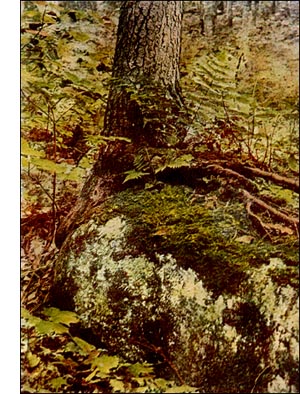Genus Thuidium
 HYPNUM: Sub-genus THUIDIUM, Schimp.
HYPNUM: Sub-genus THUIDIUM, Schimp.The species of this sub-genus are fern-like and grow in dense flat mats on decaying wood.
The generic name is derived from the Greek for; an ancient name for some resinous-bearing evergreen. The moss was so called by Wm. Philipp Schimper, from its resemblance to a tiny cedar tree.
The primary stems are densely covered with rootlets, and the secondary are 1 to 3 times pinnately branching. The leaves on the stem are triangular heart-shaped with a strong vein, a more or less longpointed apex, and a base extending downward on the stem ; papillae are found on one or both faces ; leaf-like organs (paraphyllia) on the stem between the true leaves are numerous and of many forms.
The leaves on the branches are smaller, ovate, lance-shaped, concave and overlapping; the cells are small, round, six-sided, sometimes long, linear at the base and four-sided on the borders. The leaves at the base of the pedicel are long, and overlapping.
The spore-cases are narrowly ovate or cylindrical and arched, with conical or more or less long-beaked lids and long pedicels. The teeth are as in the genus Hypnum.
Two hundred and fortyfour species are known at present, fifteen of them in North America.
Veil (calyptra).-Split up one side.
Spore-case.-Oblong-egg-shaped, nodding or horizontal, dark yellow-brown when old.
Pedicel (seta).-Smooth and 3/4 to 1 inch long.
Lid (operculum).-With a long awl-shaped beak.
Annulus.-Large, of three rows of cells.
Teeth (peristome).-Double, as in genus Hypnum.
Spores.-Mature in autumn.
Distribution.-North America, Europe, Africa.
Dainty Cedar Moss
Tiny Cedar Moss